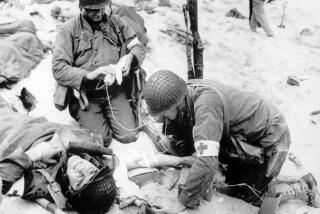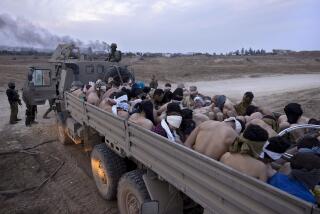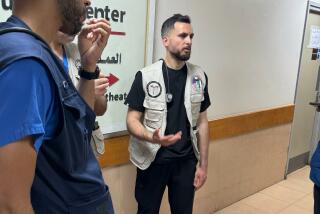GIs’ Survival Chances Rise as Medical Care Improves : Gulf crisis: The wounded would have the best odds of any conflict to date, American doctors believe.
- Share via
EASTERN SAUDI ARABIA — With nearly a million troops from 29 nations poised for combat in the Persian Gulf, allied military commanders have put in place the most advanced medical facilities ever known to handle casualties of war.
The opposing forces--Iraq alone on one side of the Kuwaiti border, 28 Arab and Western military forces on the other--have at their disposal a fearsome conventional arsenal: missiles than can travel hundreds of miles, bombers with payloads of 30 tons, deadly gas, the newest tanks and ground-unit firepower ranging from assault rifles to long-range artillery.
But U.S. doctors here believe that if hostilities break out, the chances of American soldiers surviving battlefield wounds would be better than ever before. Every non-nuclear war, in fact, has become more survivable than the one before it because of medical progress and speedier evacuation of the wounded to rear-echelon hospitals.
“Basically, we’re looking at pretty much the same situation as Vietnam,” said Navy Capt. Jerry Grim of Fallbrook, Calif., the senior doctor for the Marine Expeditionary Force in the gulf region.
“The wounded are generally going to get back to good medical care within that first so-called golden hour. With the facilities we’ve got here now, I’d expect that the mortality rate would be lower than it’s been in other wars.”
In the Vietnam War, more than 90% of American casualties survived.
One new concept being tried in the gulf is the deployment of a mobile, land-based, Navy-run fleet hospital that is as sophisticated as a hospital ship. The self-contained tent hospital, including 500 beds in 14 wards, six operating tables and a staff of 80 doctors, is shipped in 406 containers and can be unpacked, set up and made operational in about two weeks. Four helicopter pads are located nearby.
At Fleet Hospital 5 in Saudi Arabia’s Eastern province, doctors say the initial volume of casualties could be high because of the amount of firepower massed on both sides of the Kuwaiti border. Excluding the possibility of chemical warfare, however, they do not expect a conflict in the gulf to produce unfamiliar medical problems. In previous combat situations, injuries to the extremities have accounted for 35% to 40% of the casualties, abdominal wounds 20% to 25%, head wounds 15% and chest wounds 15% to 20%.
“We’re doing here what we did at home,” said Lt. Cmdr. Keith Pumroy of Chesapeake, Va. “Most of us have worked at a trauma center in the states, and the type of patient we’d see in combat wouldn’t be that different. The only difference would be in the volume of patients.”
Some doctors complain that spare parts for their sophisticated medical equipment have been slow to arrive, and others say certain medicines, such as diarrhea pills, were initially in short supply.
But the supply lines seem to be working adequately now, and doctors are encouraged because communicable diseases--which caused more deaths in World War II than bullets--are minimal in the gulf. Also, Saudi Arabia is a clean, sanitary country, lessening the chances of post-operative infections.
“Life was a bitch at first,” said Lt. Cmdr. Mike Mozzetti of San Diego, an emergency medical physician at the fleet hospital. “But once we set up the hospital and got busy, things steadily improved, and I’d say morale is very good now.”
“Our biggest concern (is) that a lot of us feel our skills declining. That’s the major problem with the medical corps. You have to have patients to do things. It’s not that you forget how to be a physician. It’s just that your skills aren’t as sharp when you aren’t using them every day.”
Many wounds in Vietnam were caused by snipers, small-unit firefights and poisoned punji sticks hidden in the ground. With the exception of the Tet offensive, some sieges such as Khe Sahn and some battles such as Hamburger Hill and the Ia Drang Valley, fighting was not sustained, and flash points of massive casualties were few. But the potential conflict in the gulf presents military planners with new imponderables.
Will helicopters be as useful for evacuation in the wide-open desert as they were in the jungle? Will there be more burn victims because of tank battles? Are the hospitals large enough to handle a sudden influx of casualties far greater than seen in a guerrilla war?
How great is the threat of nerve gas, which Iraqi President Saddam Hussein used against Iranians and his own Kurdish minority? Is it true that Iraq has equipped Scud missiles with gas canisters?
The possibility of chemical warfare has spooked U.S. soldiers, although senior commanders consider use of nerve or mustard gas more of “a nuisance,” in one officer’s words, than an effective tactic. American soldiers have trained extensively here with MOPP (mission-oriented protective posture) anti-gas equipment that includes masks, gloves, wrap-about uniforms and self-injected antidotes. During the Iran-Iraq War, fewer than 3% of gas victims died.
“We’re obviously taking the threat of Scud-fired gas seriously, though we don’t know if Iraq really has that capability or not,” said Cmdr. Thad Zajdowicz, an internal medicine specialist. “Yes, people will die if chemical weapons are employed, but it’s not going to be like a line of insects falling over when they’re sprayed with Raid. Most of the fighting men probably would be unaffected.
“Chemical weapons for the most part are employed at the forward edge of the battle area because of the limited range of the artillery that fires them. In this environment, nerve-gas agents would dissipate within minutes because of the sun and constant wind. The blistering agents of mustard gas would persist much longer. Things that they hit could remain contaminated for days or weeks.”
Decontamination of people and equipment involves washing down with high-pressure sprays--and it ideally is handled in the field, before a victim reaches a rear-echelon facility. A gas attack that incapacitates large numbers of soldiers could severely disrupt the military’s ability to handle the flow of casualties. The new U.S. M1-A1 Abrams tanks now arriving from Germany, which are designed to be resistant to chemical warfare, are particularly well suited to the current crisis.
The strategy of handling casualties remains largely unchanged since the Vietnam War. A wounded soldier is treated first by corpsmen assigned to all infantry platoons. If hurt seriously enough, the victim then works his way back toward the rear, to the small, forward-based MASH (mobile Army surgical hospital) units at battalion level, and finally to a fleet or ship hospital, which has the capability to perform any operation short of open heart or brain surgery. The most serious cases would be flown to hospitals in Europe or the United States.
“When I was an intern and resident, my professors would scream and holler at you, and you knew there was no room for second best,” said Maj. David Remedios, who studied under heart surgeon Michael E. DeBakey in Houston. “Here (in a MASH unit), you do the best you can.”
Doctors say it is impossible to estimate precisely how many casualties they could handle in the Persian Gulf theater in an hour or a day. But it is certain that if thousands of Americans were struck down in a short period, the medical system would become overloaded and evacuation to rear facilities would be greatly slowed. In such an event, the death rate would almost certainly be substantial.
The massive medical buildup in the gulf underscores how serious the threat of war is and how destructive it could be.
In addition to numerous forward facilities, the United States has on station Fleet Hospital 5, and plans to deploy two more fleet hospitals are under consideration. Two floating hospitals, the Mercy and the Comfort, have been deployed off the coast. The converted oil tankers each have 1,000 beds, 12 operating theaters and staffs of 900. Only eight hospitals in the world are larger than the Mercy or Comfort, Pentagon officials said.
The Air Force is capable of flying 1,000 patients a day to medical facilities in Frankfurt, Landstuhl and Wiesbaden, Germany; three British bases in Britain and Incirlik in Turkey.
At the end of World War II, the military operated hospitals with half a million beds. The Defense Department’s bed capacity now is 17,500, expandable to 50,000 in a short time.
In 1982, Congress said that in times of crisis, military and Veterans Administration hospitals should be prepared to handle casualties. VA Secretary Edward J. Derwinski said recently that his 172 hospitals--22 of which are designated to receive chemical war casualties--could provide 12,610 beds within 24 hours and 25,000 beds within 30 days.
Fifty-six Americans have died of various causes in Saudi Arabia since the U.S. deployment began in early August. About 2,300 others have been evacuated to hospitals in Europe and the United States with injuries, most of them orthopedic.
Times staff writers Douglas Jehl and John M. Broder in Washington and Kenneth Reich in Los Angeles contributed to this report.
More to Read
Sign up for Essential California
The most important California stories and recommendations in your inbox every morning.
You may occasionally receive promotional content from the Los Angeles Times.










